Abstract
2,512 consecutive patients with papillary thyroid carcinoma (PTC) were managed during 1940 through 2000 at the Mayo Clinic. During that period, there were two significant therapeutic trends. The first was a change in surgical practice during 1940-69 from an initial unilateral lobectomy (UL) to a bilateral lobar resection (BLR). The second was the increasing use since 1970 of I-131 for radioactive-iodine remnant ablation (RRA). The advent of BLR resulted in significantly improved tumor recurrence (TR) rates in both low-risk (MACIS scores < 6) and high-risk (MACIS scores 6+) patients, and also reduced cause-specific mortality (CSM) in high-risk patients. By contrast, RRA did not significantly improve the outcome (either CSM or TR) in low-risk (MACIS < 6) patients previously treated with initial near-total or total thyroidectomy. These data encourage a more selective use of I-131 in PTC management and do not lend support to the current widespread use of RRA in low-risk PTC.
Full text
PDF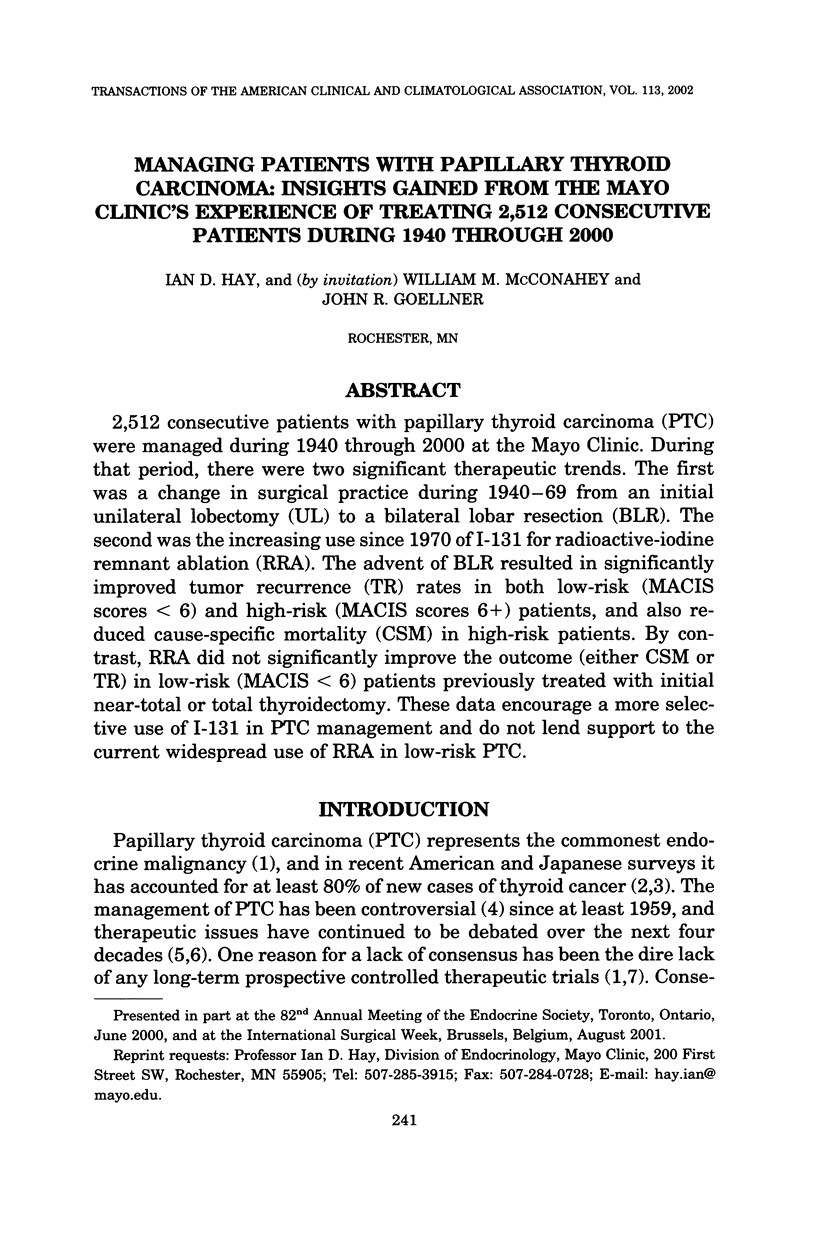
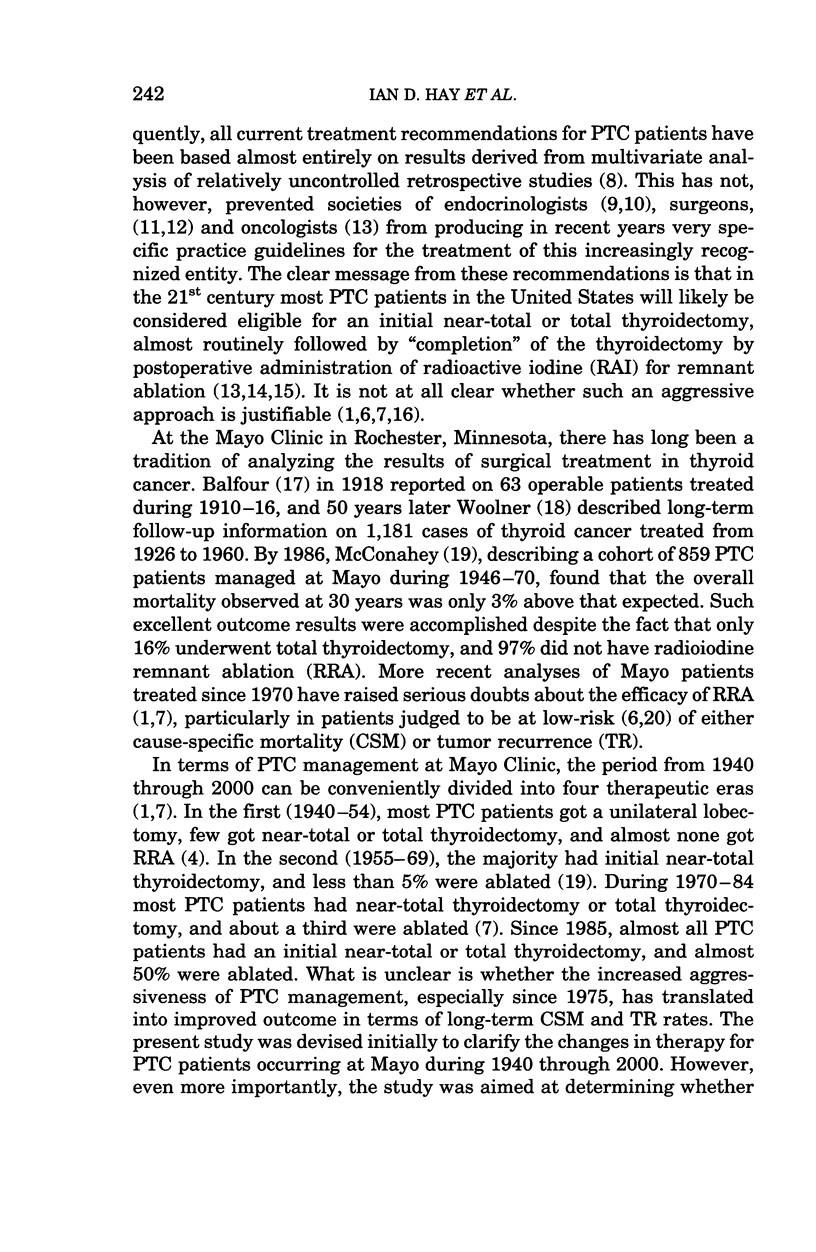



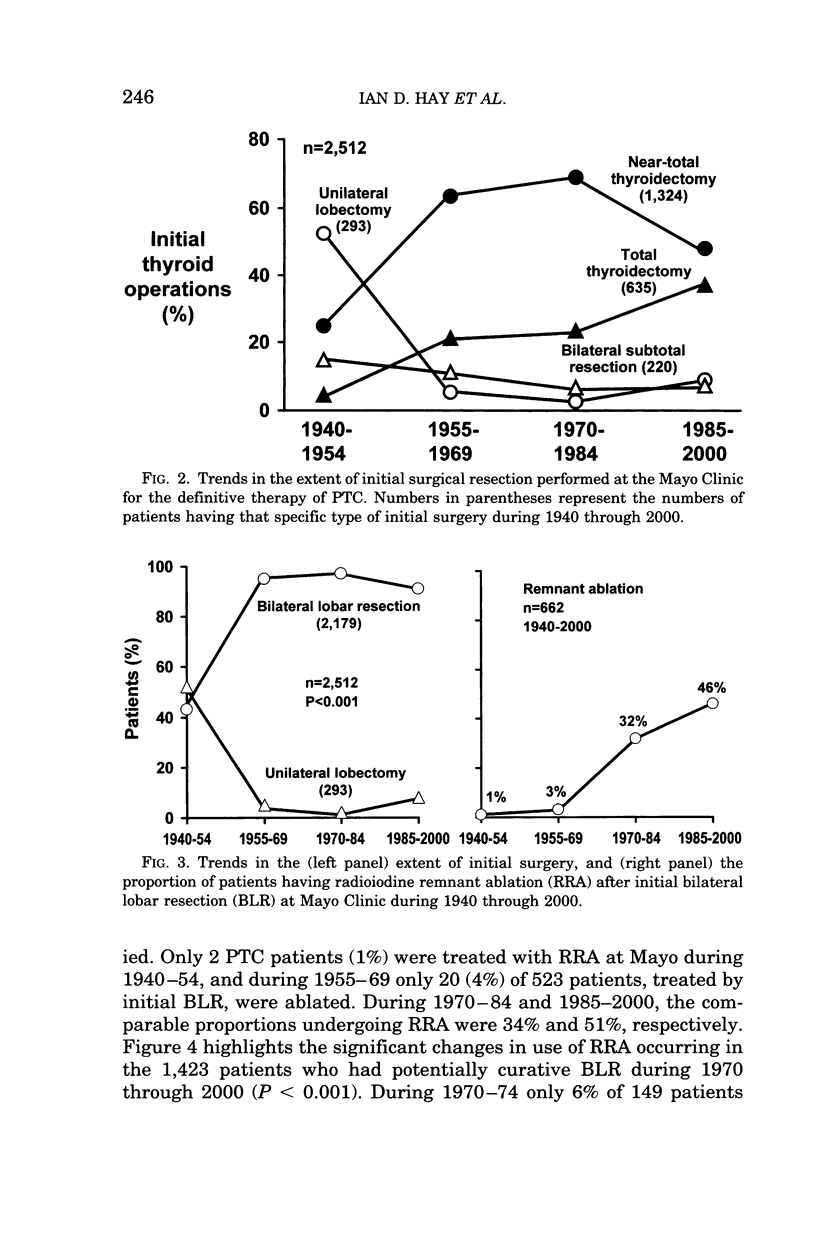

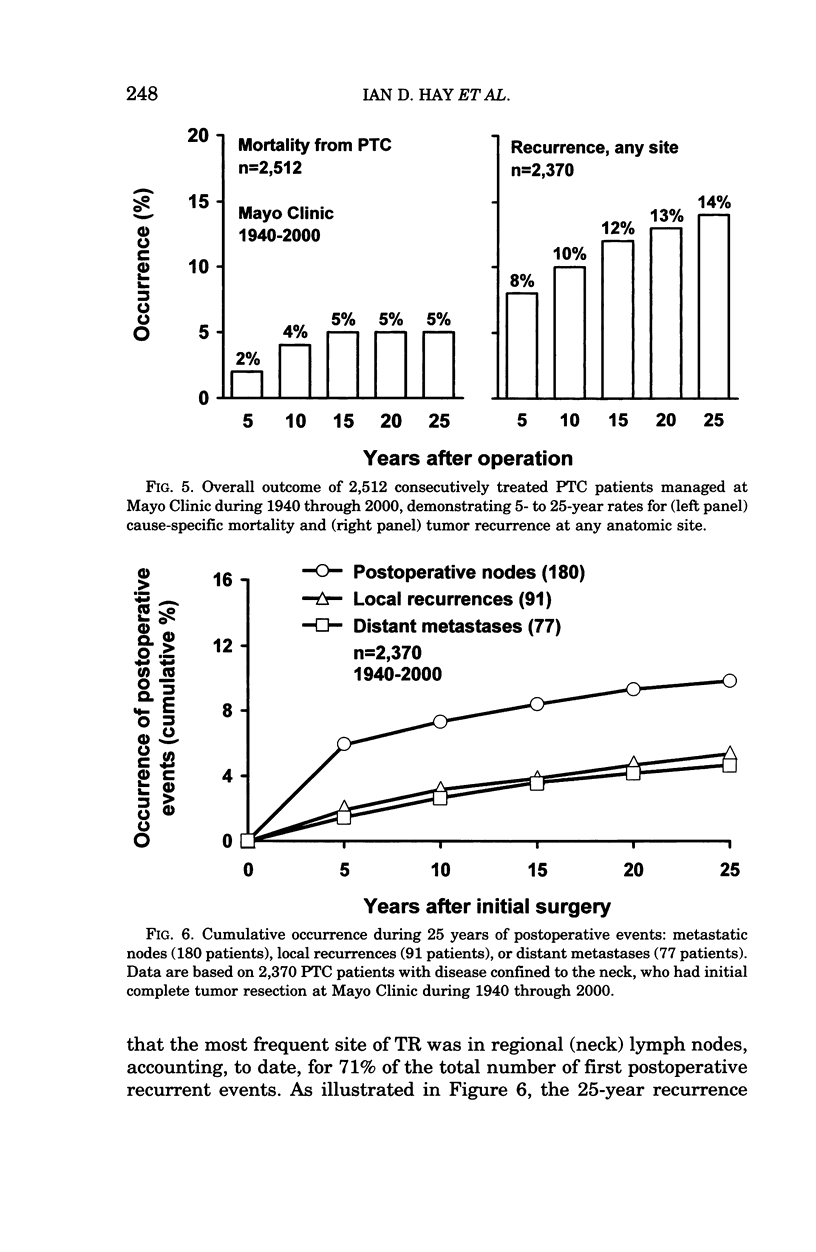
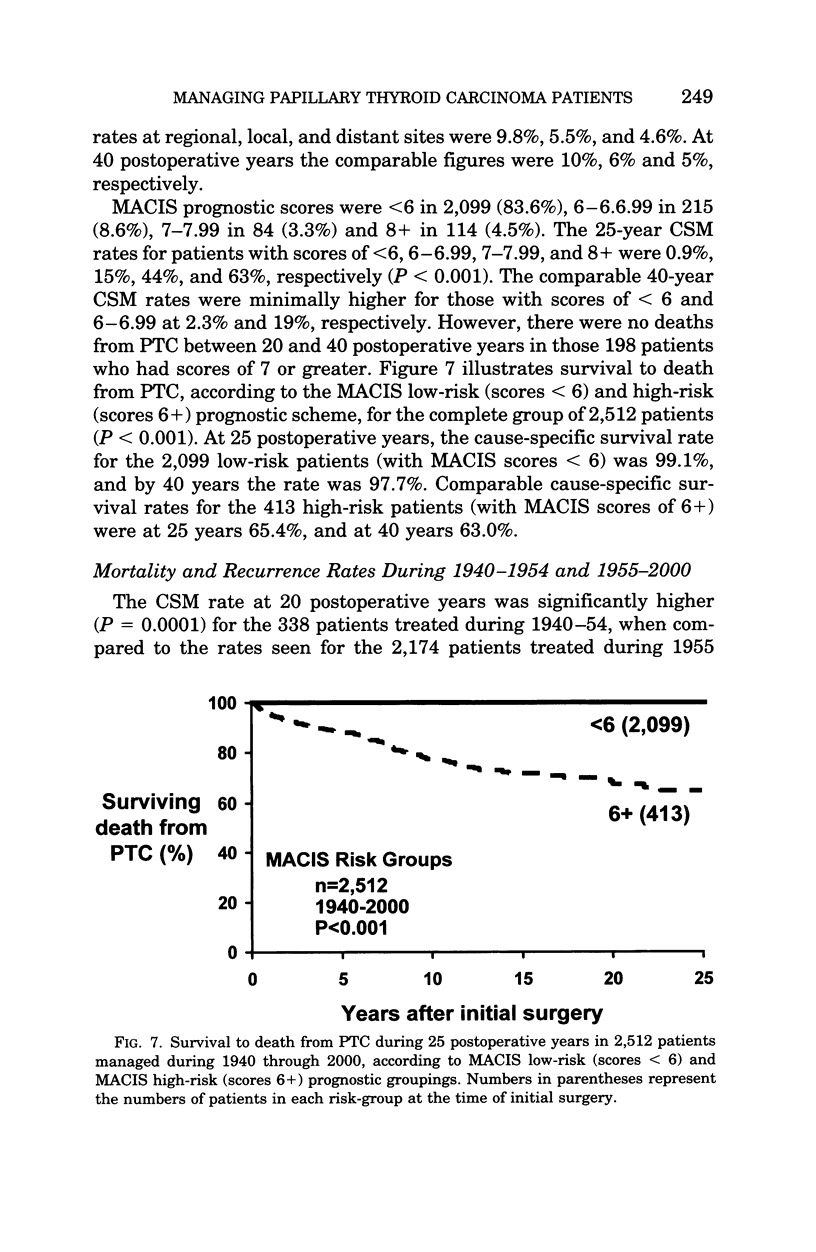
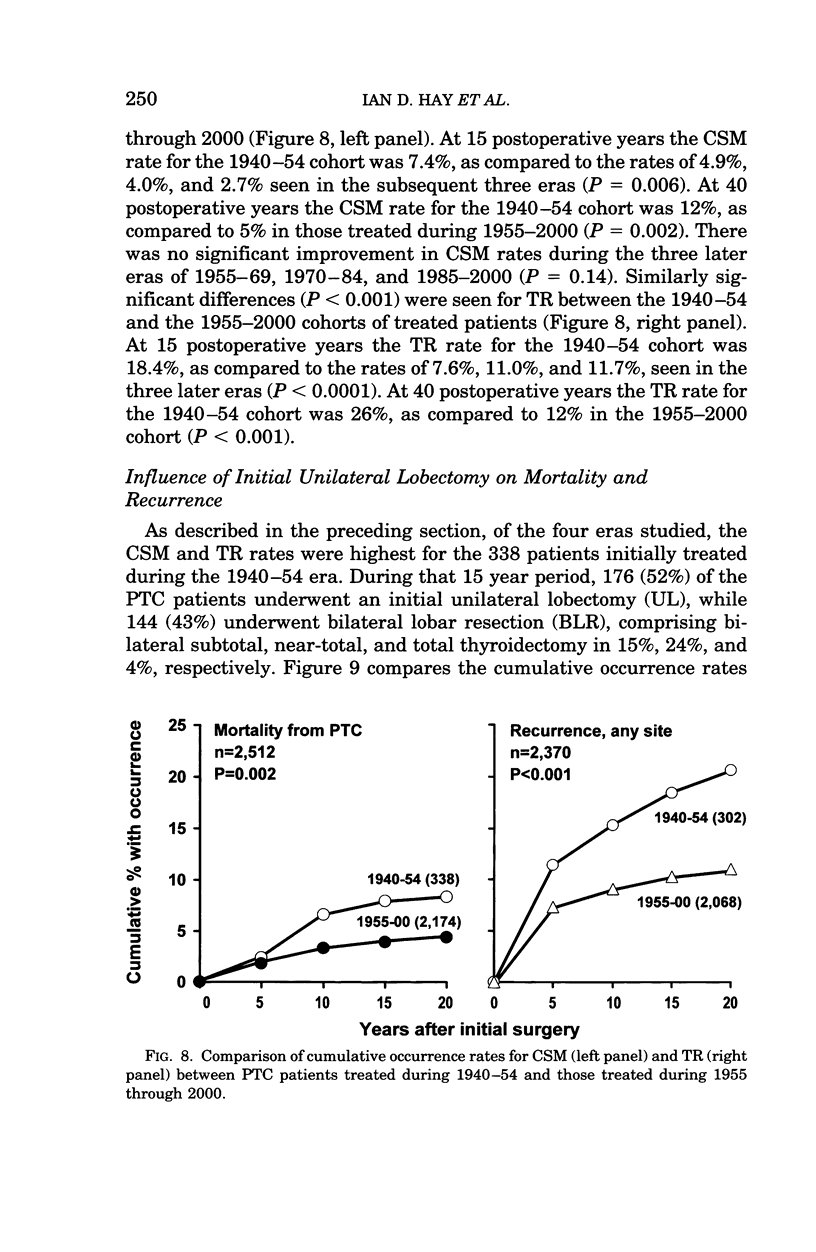

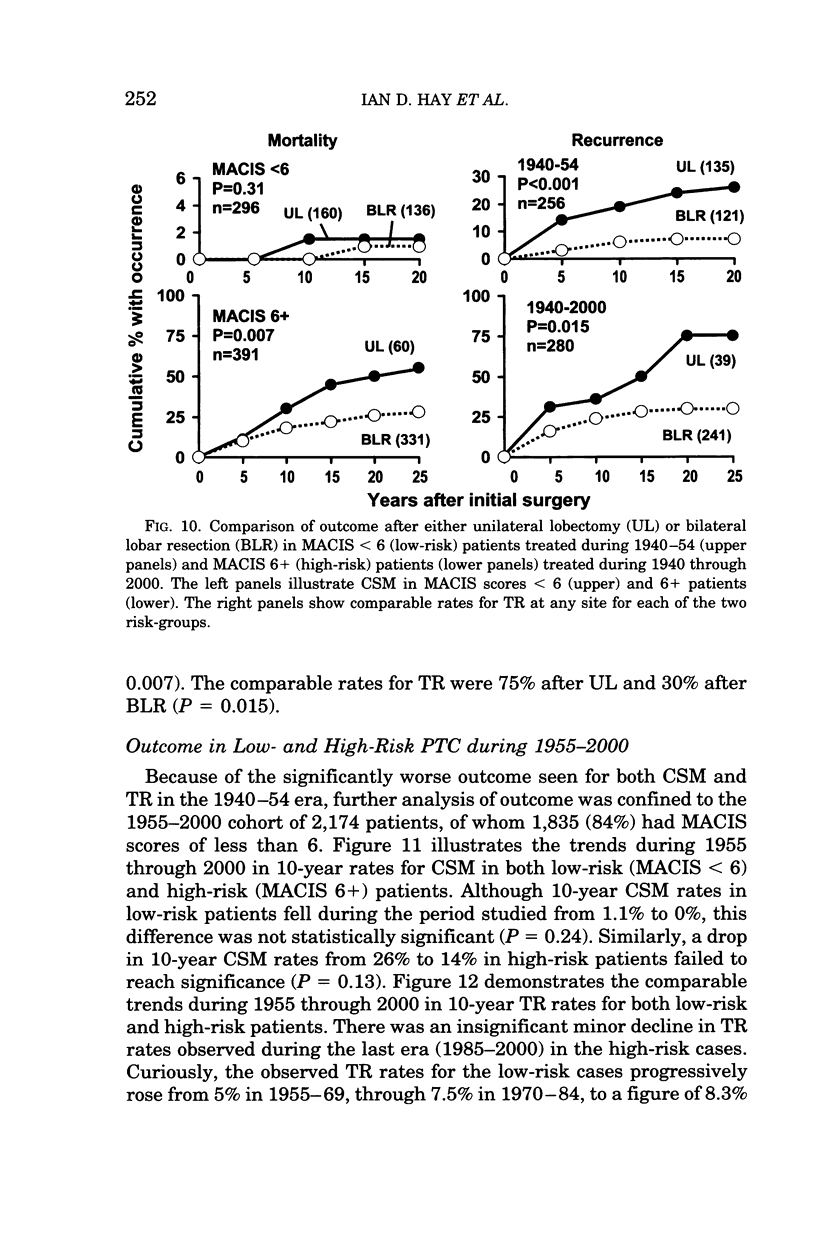
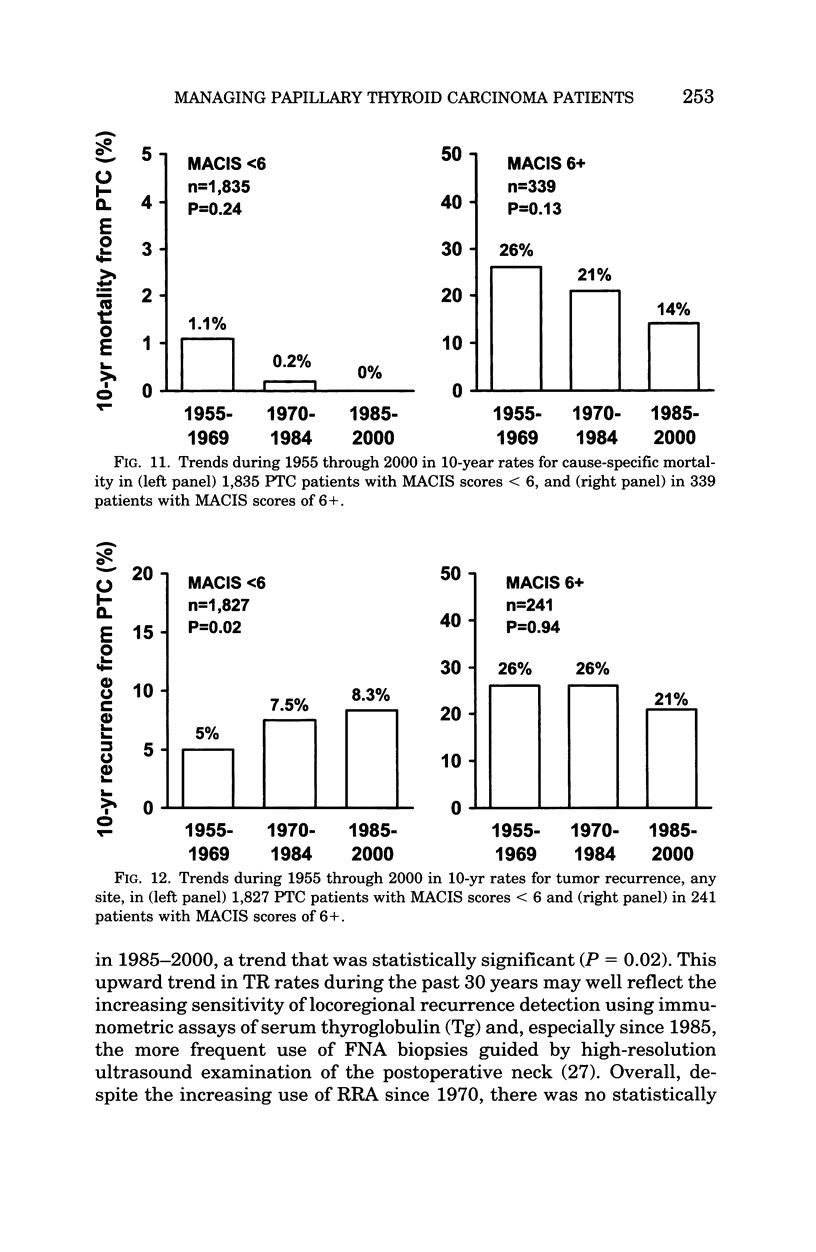
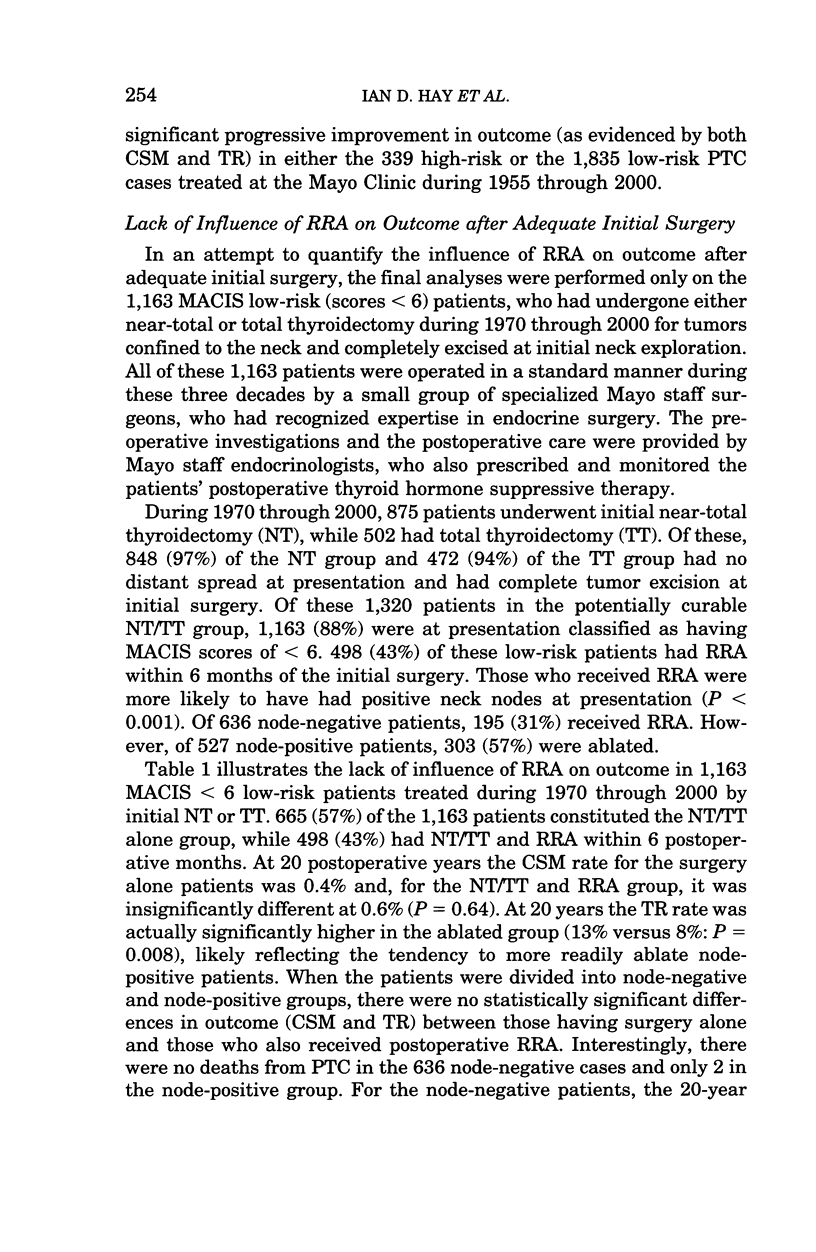
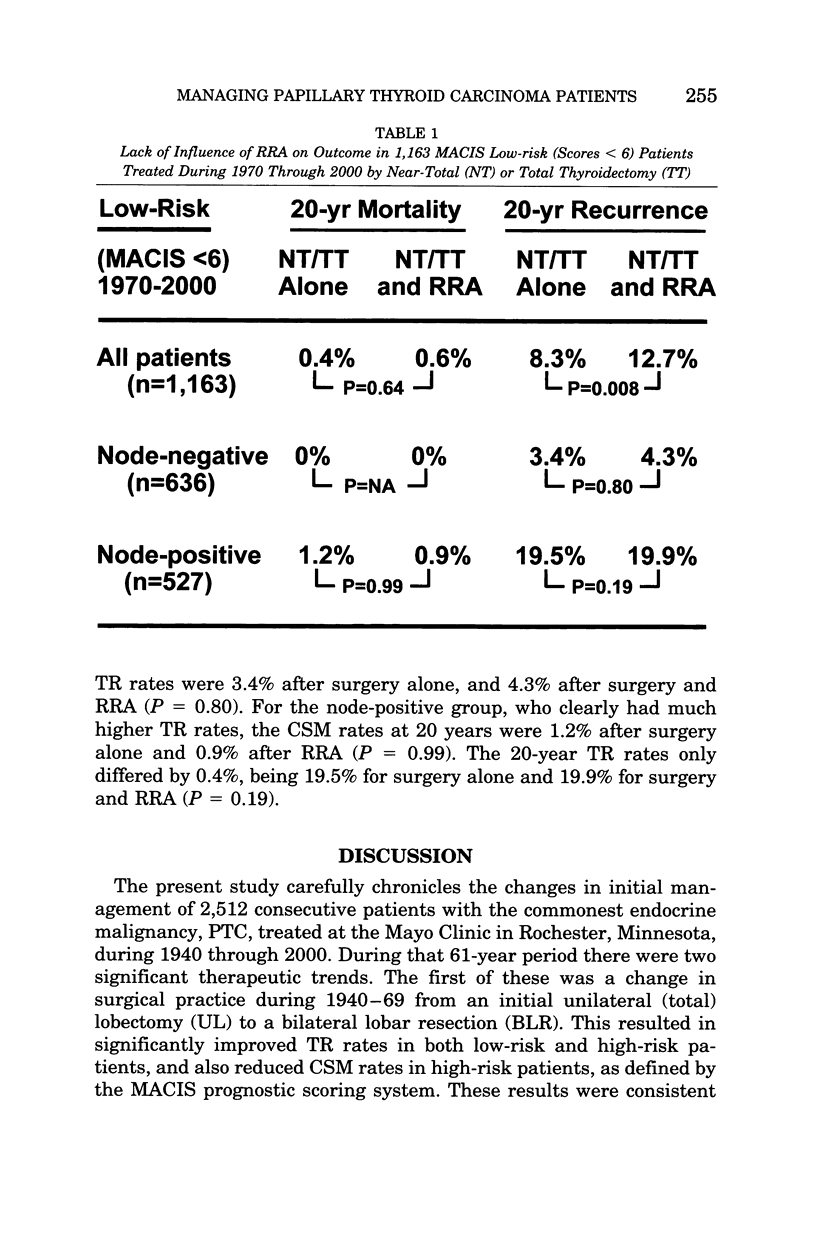


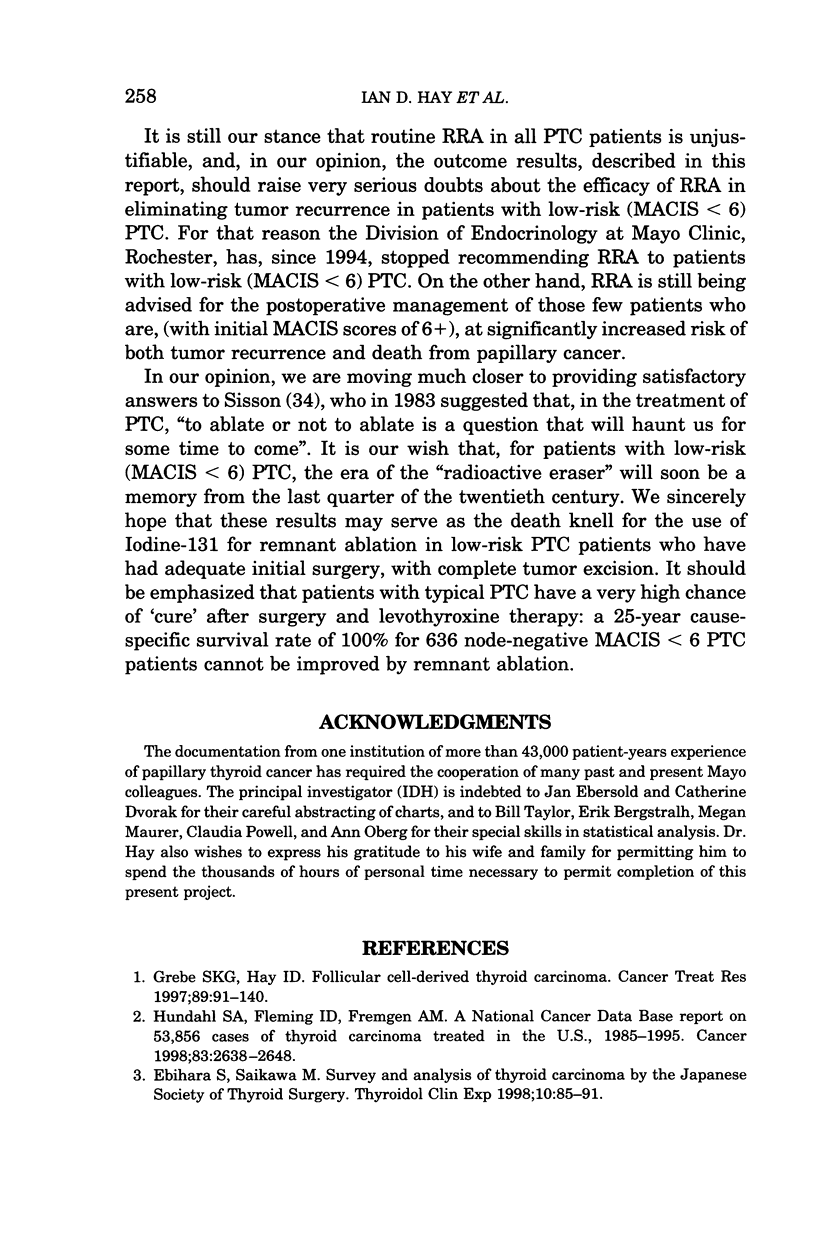
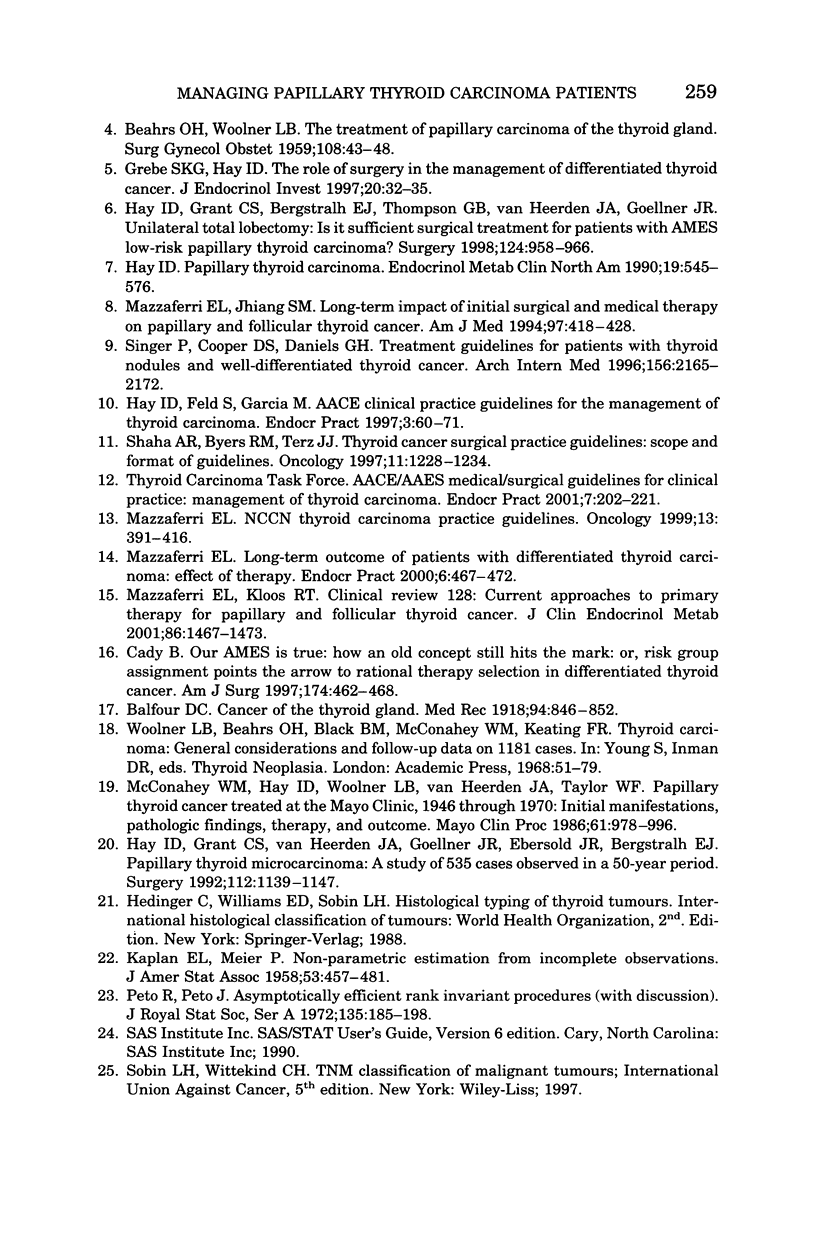
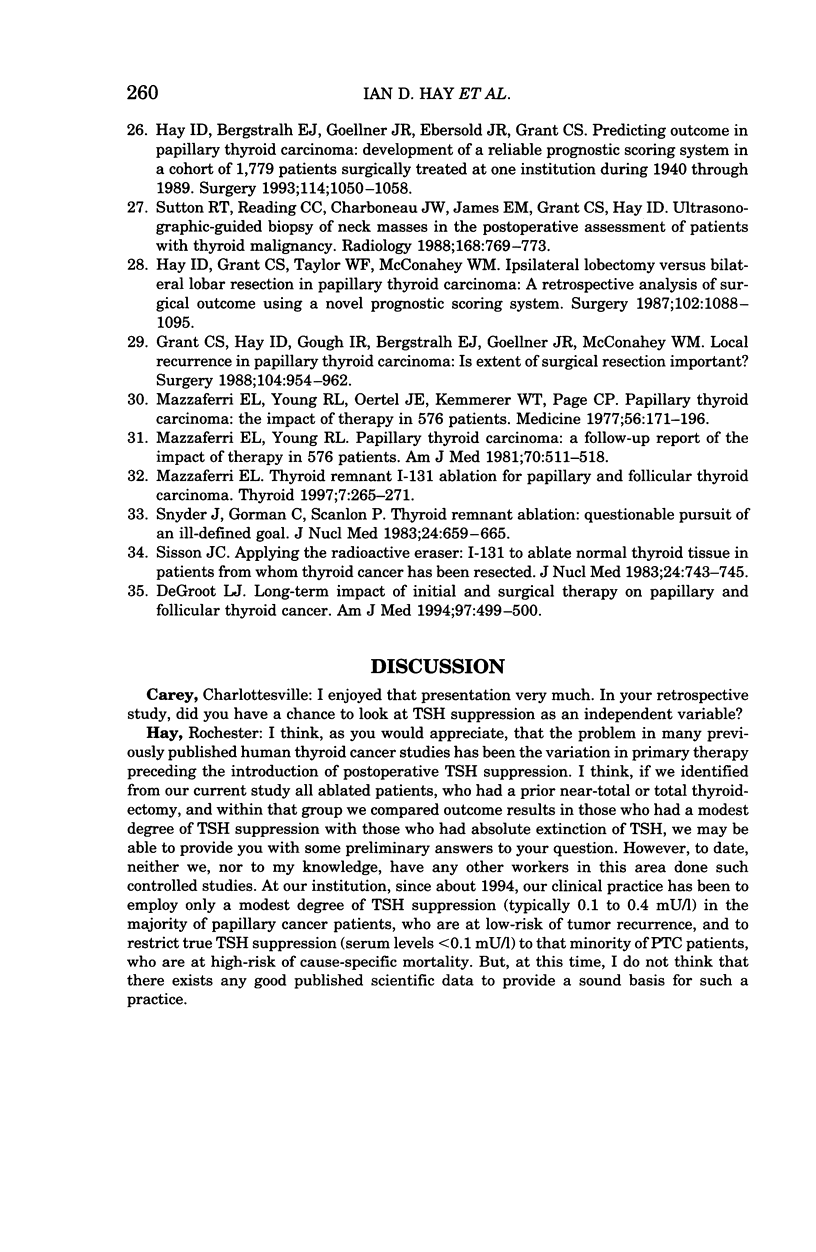
Selected References
These references are in PubMed. This may not be the complete list of references from this article.
- BEAHRS O. H., WOOLNER L. B. The treatment of papillary carcinoma of the thyroid gland. Surg Gynecol Obstet. 1959 Jan;108(1):43–48. [PubMed] [Google Scholar]
- Cady B. Hayes Martin Lecture. Our AMES is true: how an old concept still hits the mark: or, risk group assignment points the arrow to rational therapy selection in differentiated thyroid cancer. Am J Surg. 1997 Nov;174(5):462–468. doi: 10.1016/s0002-9610(97)00162-1. [DOI] [PubMed] [Google Scholar]
- Cobin R. H., Gharib H., Bergman D. A., Clark O. H., Cooper D. S., Daniels G. H., Dickey R. A., Duick D. S., Garber J. R., Hay I. D. AACE/AAES medical/surgical guidelines for clinical practice: management of thyroid carcinoma. American Association of Clinical Endocrinologists. American College of Endocrinology. Endocr Pract. 2001 May-Jun;7(3):202–220. [PubMed] [Google Scholar]
- DeGroot L. J. Long-term impact of initial and surgical therapy on papillary and follicular thyroid cancer. Am J Med. 1994 Dec;97(6):499–500. doi: 10.1016/0002-9343(94)90342-5. [DOI] [PubMed] [Google Scholar]
- Grant C. S., Hay I. D., Gough I. R., Bergstralh E. J., Goellner J. R., McConahey W. M. Local recurrence in papillary thyroid carcinoma: is extent of surgical resection important? Surgery. 1988 Dec;104(6):954–962. [PubMed] [Google Scholar]
- Grebe S. K., Hay I. D. Follicular cell-derived thyroid carcinomas. Cancer Treat Res. 1997;89:91–140. doi: 10.1007/978-1-4615-6355-6_6. [DOI] [PubMed] [Google Scholar]
- Grebe S. K., Hay I. D. The role of surgery in the management of differentiated thyroid cancer. J Endocrinol Invest. 1997 Jan;20(1):32–35. doi: 10.1007/BF03347970. [DOI] [PubMed] [Google Scholar]
- Hay I. D., Bergstralh E. J., Goellner J. R., Ebersold J. R., Grant C. S. Predicting outcome in papillary thyroid carcinoma: development of a reliable prognostic scoring system in a cohort of 1779 patients surgically treated at one institution during 1940 through 1989. Surgery. 1993 Dec;114(6):1050–1058. [PubMed] [Google Scholar]
- Hay I. D., Grant C. S., Bergstralh E. J., Thompson G. B., van Heerden J. A., Goellner J. R. Unilateral total lobectomy: is it sufficient surgical treatment for patients with AMES low-risk papillary thyroid carcinoma? Surgery. 1998 Dec;124(6):958–966. [PubMed] [Google Scholar]
- Hay I. D., Grant C. S., Taylor W. F., McConahey W. M. Ipsilateral lobectomy versus bilateral lobar resection in papillary thyroid carcinoma: a retrospective analysis of surgical outcome using a novel prognostic scoring system. Surgery. 1987 Dec;102(6):1088–1095. [PubMed] [Google Scholar]
- Hay I. D., Grant C. S., van Heerden J. A., Goellner J. R., Ebersold J. R., Bergstralh E. J. Papillary thyroid microcarcinoma: a study of 535 cases observed in a 50-year period. Surgery. 1992 Dec;112(6):1139–1147. [PubMed] [Google Scholar]
- Hay I. D. Papillary thyroid carcinoma. Endocrinol Metab Clin North Am. 1990 Sep;19(3):545–576. [PubMed] [Google Scholar]
- Hundahl S. A., Fleming I. D., Fremgen A. M., Menck H. R. A National Cancer Data Base report on 53,856 cases of thyroid carcinoma treated in the U.S., 1985-1995 [see commetns]. Cancer. 1998 Dec 15;83(12):2638–2648. doi: 10.1002/(sici)1097-0142(19981215)83:12<2638::aid-cncr31>3.0.co;2-1. [DOI] [PubMed] [Google Scholar]
- Mazzaferri E. L., Jhiang S. M. Long-term impact of initial surgical and medical therapy on papillary and follicular thyroid cancer. Am J Med. 1994 Nov;97(5):418–428. doi: 10.1016/0002-9343(94)90321-2. [DOI] [PubMed] [Google Scholar]
- Mazzaferri E. L. Thyroid remnant 131I ablation for papillary and follicular thyroid carcinoma. Thyroid. 1997 Apr;7(2):265–271. doi: 10.1089/thy.1997.7.265. [DOI] [PubMed] [Google Scholar]
- Mazzaferri E. L., Young R. L., Oertel J. E., Kemmerer W. T., Page C. P. Papillary thyroid carcinoma: the impact of therapy in 576 patients. Medicine (Baltimore) 1977 May;56(3):171–196. [PubMed] [Google Scholar]
- Mazzaferri E. L., Young R. L. Papillary thyroid carcinoma: a 10 year follow-up report of the impact of therapy in 576 patients. Am J Med. 1981 Mar;70(3):511–518. doi: 10.1016/0002-9343(81)90573-8. [DOI] [PubMed] [Google Scholar]
- McConahey W. M., Hay I. D., Woolner L. B., van Heerden J. A., Taylor W. F. Papillary thyroid cancer treated at the Mayo Clinic, 1946 through 1970: initial manifestations, pathologic findings, therapy, and outcome. Mayo Clin Proc. 1986 Dec;61(12):978–996. doi: 10.1016/s0025-6196(12)62641-x. [DOI] [PubMed] [Google Scholar]
- Singer P. A., Cooper D. S., Daniels G. H., Ladenson P. W., Greenspan F. S., Levy E. G., Braverman L. E., Clark O. H., McDougall I. R., Ain K. V. Treatment guidelines for patients with thyroid nodules and well-differentiated thyroid cancer. American Thyroid Association. Arch Intern Med. 1996 Oct 28;156(19):2165–2172. [PubMed] [Google Scholar]
- Sisson J. C. Applying the radioactive eraser: I-131 to ablate normal thyroid tissue in patients from whom thyroid cancer has been resected. J Nucl Med. 1983 Aug;24(8):743–745. [PubMed] [Google Scholar]
- Snyder J., Gorman C., Scanlon P. Thyroid remnant ablation: questionable pursuit of an ill-defined goal. J Nucl Med. 1983 Aug;24(8):659–665. [PubMed] [Google Scholar]
- Society of Surgical Oncology Practice Guidelines. Thyroid cancer surgical practice guidelines. Oncology (Williston Park) 1997 Aug;11(8):1228-32, 1234. [PubMed] [Google Scholar]
- Sutton R. T., Reading C. C., Charboneau J. W., James E. M., Grant C. S., Hay I. D. US-guided biopsy of neck masses in postoperative management of patients with thyroid cancer. Radiology. 1988 Sep;168(3):769–772. doi: 10.1148/radiology.168.3.3043550. [DOI] [PubMed] [Google Scholar]


